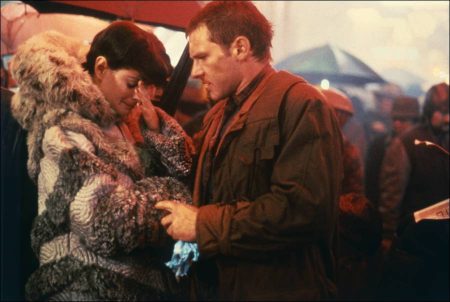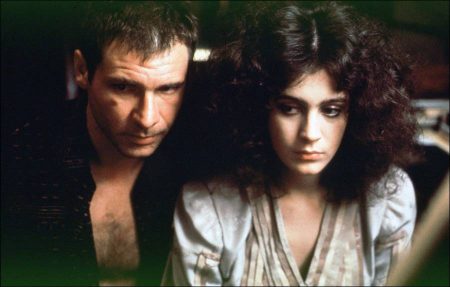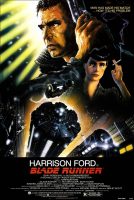Blade Runner movie storyline. In 2019 Los Angeles, former policeman Rick Deckard is detained by Officer Gaff, and brought to his former supervisor, Bryant. Deckard, whose job as a “blade runner” was to track down bioengineered humanoids known as replicants and terminally “retire” them, is informed that four replicants are on Earth illegally. Deckard begins to leave, but Bryant ambiguously threatens him and Deckard stays. The two watch a video of a blade runner named Holden administering the Voight-Kampff test, which is designed to distinguish replicants from humans based on their emotional response to questions. The test subject, Leon, shoots Holden on the second question. Bryant wants Deckard to retire Leon and three other Nexus-6 replicants: Roy Batty, Zhora, and Pris.
Bryant has Deckard meet with the CEO of the company that creates the replicants, Eldon Tyrell, so he can administer the test on a Nexus-6 to see if it works. Tyrell expresses his interest in seeing the test fail first and asks him to administer it on his assistant Rachael. After a much longer than standard test, Deckard concludes that Rachael is a replicant who believes she is human. Tyrell explains that she is an experiment who has been given false memories to provide an “emotional cushion”.
Searching Leon’s hotel room, Deckard finds photos and a synthetic snake scale. Roy and Leon investigate a replicant eye-manufacturing laboratory and learn of J. F. Sebastian, a gifted genetic designer who works closely with Tyrell. Deckard returns to his apartment where Rachael is waiting. She tries to prove her humanity by showing him a family photo but, after Deckard reveals that her memories are implants from Tyrell’s niece, she leaves in tears. Meanwhile, Pris locates Sebastian and manipulates him to gain his trust.
A photograph from Leon’s apartment and the snake scale lead Deckard to a strip club, where Zhora works. After a confrontation and chase, Deckard kills Zhora. Bryant also orders him to retire Rachael, who has disappeared from the Tyrell Corporation. After Deckard spots Rachael in a crowd, he is ambushed by Leon, who knocks the gun out of Deckard’s hand and attacks him. As Leon is about to kill Deckard, Rachael saves him by using Deckard’s gun to kill Leon. They return to Deckard’s apartment and, during a discussion, he promises not to track her down. As Rachael abruptly tries to leave, Deckard restrains her and forces her to kiss him, and she ultimately relents.
Arriving at Sebastian’s apartment, Roy tells Pris that the other replicants are dead. Sympathetic to their plight, Sebastian reveals that because of “Methuselah Syndrome”, a genetic premature aging disorder, his life will be cut short, just like the replicants that were built with a four-year lifespan. Sebastian and Roy gain entrance into Tyrell’s penthouse, where Roy demands more life from his maker. Tyrell tells him that it is impossible. Roy confesses that he has done “questionable things” but Tyrell dismisses this, praising Roy’s advanced design and accomplishments in his short life. Roy kisses Tyrell, then kills him. Sebastian runs for the elevator, followed by Roy, who rides the elevator down alone. Deckard is later told by Bryant that Sebastian was found dead.
At Sebastian’s apartment, Deckard is ambushed by Pris, but he kills her as Roy returns. Roy’s body begins to fail as the end of his lifespan nears. He chases Deckard through the building, ending up on the roof. Deckard tries to jump onto another roof but is left hanging on the edge. Roy makes the jump with ease and, as Deckard’s grip loosens, Roy hoists him onto the roof to save him. Before Roy dies, he delivers a monologue about how his memories “will be lost in time, like tears in rain”. Gaff arrives and shouts to Deckard about Rachael: “It’s too bad she won’t live, but then again, who does?” Deckard returns to his apartment and finds Rachael asleep in his bed. Deckard sees an origami unicorn which makes him recall Gaff’s words. He leaves the apartment block with Rachael.
Blade Runner is a 1982 science fiction film directed by Ridley Scott, and written by Hampton Fancher and David Peoples. Starring Harrison Ford, Rutger Hauer, Sean Young, and Edward James Olmos, it is loosely based on Philip K. Dick’s 1968 novel Do Androids Dream of Electric Sheep?. The film is set in a dystopian future Los Angeles of 2019, in which synthetic humans known as replicants are bio-engineered by the powerful Tyrell Corporation to work at space colonies. When a fugitive group of advanced replicants led by Roy Batty (Hauer) escapes back to Earth, burnt-out cop Rick Deckard (Ford) reluctantly agrees to hunt them down.
Blade Runner initially underperformed in North American theaters and polarized critics; some praised its thematic complexity and visuals, while others critiqued its slow pacing and lack of action. It later became an acclaimed cult film regarded as one of the all-time best science fiction films. Hailed for its production design depicting a decaying future, Blade Runner is a leading example of neo-noir cinema. The film’s soundtrack, composed by Vangelis, was nominated in 1982 for a BAFTA and a Golden Globe as best original score.
The film has influenced many science fiction films, video games, anime, and television series. It brought the work of Philip K. Dick to the attention of Hollywood, and several later big-budget films were based on his work, such as Total Recall (1990), Minority Report (2002) and A Scanner Darkly (2006). In the year after its release, Blade Runner won the Hugo Award for Best Dramatic Presentation, and in 1993 it was selected for preservation in the U.S. National Film Registry by the Library of Congress as being “culturally, historically, or aesthetically significant”. A sequel, Blade Runner 2049, was released in October 2017.
Seven different versions of Blade Runner exist as a result of controversial changes requested by studio executives. A director’s cut was released in 1992 after a strong response to test screenings of a workprint. This, in conjunction with the film’s popularity as a video rental, made it one of the earliest movies to be released on DVD. In 2007, Warner Bros. released The Final Cut, a 25th-anniversary digitally remastered version. This is the only version over which Scott retained artistic control.
About the Themes
The film operates on multiple dramatic and narrative levels. It employs some of the conventions of film noir, among them the character of a femme fatale; narration by the protagonist (in the original release); chiaroscuro cinematography; and giving the hero a questionable moral outlook – extended to include reflections upon the nature of his own humanity.
It is a literate science fiction film, thematically enfolding the philosophy of religion and moral implications of human mastery of genetic engineering in the context of classical Greek drama and hubris. It also draws on Biblical images, such as Noah’s flood, and literary sources, such as Frankenstein. Although Scott said any similarity was merely coincidental, fans claimed that the chess game between Sebastian and Tyrell was based on the famous Immortal Game of 1851.
Blade Runner delves into the effects of technology on the environment and society by reaching to the past, using literature, religious symbolism, classical dramatic themes, and film noir techniques. This tension between past, present, and future is represented in the “retrofitted” future depicted in the film, one which is high-tech and gleaming in places but decayed and outdated elsewhere. In an interview with The Observer in 2002, director Ridley Scott described the film as “extremely dark, both literally and metaphorically, with an oddly masochistic feel”. He also said that he “liked the idea of exploring pain” in the wake of his brother’s death: “When he was ill, I used to go and visit him in London, and that was really traumatic for me.”
A sense of foreboding and paranoia pervades the world of the film: corporate power looms large; the police seem omnipresent; vehicle and warning lights probe into buildings; and the consequences of huge biomedical power over the individual are explored – especially regarding replicants’ implanted memories. Control over the environment is exercised on a vast scale, and goes hand in hand with the absence of any natural life; for example, artificial animals stand in for their extinct predecessors. This oppressive backdrop explains the frequently referenced migration of humans to “off-world” (extraterrestrial) colonies. Eyes are a recurring motif, as are manipulated images, calling into question the nature of reality and our ability to accurately perceive and remember it.
These thematic elements provide an atmosphere of uncertainty for Blade Runner’s central theme of examining humanity. In order to discover replicants, an empathy test is used, with a number of its questions focused on the treatment of animals – seemingly an essential indicator of one’s “humanity”. The replicants appear to show compassion and concern for one another and are juxtaposed against human characters who lack empathy, while the mass of humanity on the streets is cold and impersonal. The film goes so far as to question if Deckard might be a replicant, in the process asking the audience to re-evaluate what it means to be human.
The question of whether Deckard is intended to be a human or a replicant has been an ongoing controversy since the film’s release. Both Michael Deeley and Harrison Ford wanted Deckard to be human, while Hampton Fancher preferred ambiguity. Ridley Scott has stated that in his vision, Deckard is a replicant. Deckard’s unicorn-dream sequence, inserted into Scott’s Director’s Cut and concomitant with Gaff’s parting gift of an origami unicorn, is seen by many as showing that Deckard is a replicant – because Gaff could have retrieved Deckard’s implanted memories.
The interpretation that Deckard is a replicant is challenged by others who believe the unicorn imagery shows that the characters, whether human or replicant, share the same dreams and recognize their affinity, or that the absence of a decisive answer is crucial to the film’s main theme. The film’s inherent ambiguity and uncertainty, as well as its textual richness, have permitted multiple interpretations.
Blade Runner (1982)
Directed by: Ridley Scott
Starring: Harrison Ford, Daryl Hannah, Rutger Hauer, Sean Young, Edward James Olmos, Joanna Cassidy, James Hong, Kevin Thompson, M. Emmet Walsh, William Sanderson, Joe Turkel, Brion James
Screenplay by: Hampton Fancher, David Peoples
Production Design by: Lawrence G. Paull
Cinematography by: Jordan Cronenweth
Film Editing by: Terry Rawlings, Marsha Nakashima
Costume Design by: Michael Kaplan, Charles Knode
Set Decoration by: Linda DeScenna, Leslie McCarthy-Frankenheimer, Thomas L. Roysden, Peg Cummings
Art Direction by: David L. Snyder
Music by: Vangelis
MPAA Rating: None.
Distributed by: Warner Bros. Pictures
Release Date: June 25, 1982
Visits: 500


